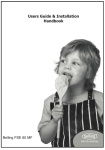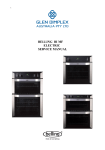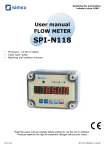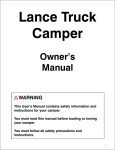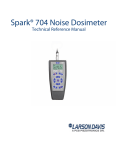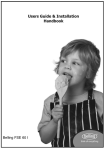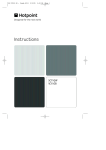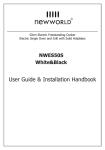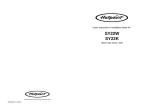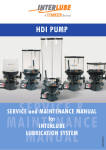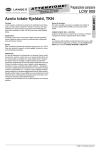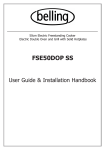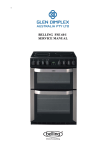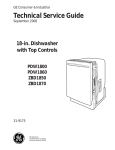Download User Manual
Transcript
Users Guide & Installation Handbook Belling Built-in Electric MF AU our warranty Should you need it . . . . Inside the paperwork which has come with this appliance, there is a leaflet and card explaining the terms of our extended warranty and guarantee. In order to apply for our five year guarantee, simply fill in the details on the card and post it off, this will register your appliance. Should you wish to take out extended warranty, please fill in the details on the leaflet and post this off to: Glen Dimplex Australia Unit 2, 205 Abbotts Road Dandenong South Victoria 3175 Australia Ph: 1300 556 816 Fx: 1800 058 900 Glen Dimplex New Zealand Pty 38 Harris Road, East Tamaki Auckland New Zealand Ph: 09 274 8265 Fx: 09 274 8472 If your appliance is covered by the warranty and guarantee, you will not be billed for work undertaken should your appliance be faulty, terms and conditions do apply, so please read through the literature carefully. Please ensure that you have available your appliances model number and serial number, there is a space at the back of this book for recording that information. IMPORTANT NOTICE Please note the cooling fan fitted to this appliance is an integral part of its safety and functionality. When the appliance is installed care must be taken that the cooling fans performance is not impeded by any objects coming into contact with it. (Installation pipes, leads etc) Care must also be taken that there is sufficient air flow at the rear of the appliance for the cooling fan to run at its optimum efficiency. (Particularly Built In appliances) See clearance dimensions in the installation section of the booklet. During use the Appliance must never be disconnected from the Mains supply as this will seriously affect the safety and performance of the appliance, particularly in relation to surface temperatures becoming hot and gas operated parts not working efficiently. The cooling fan is designed to run on after the control knob has been switched off to keep the front of the appliance and the controls cool until the appliance has naturally cooled itself. User’s Section . . . . . . . . . . . . . . . . . . . . . . . . . . . . . . . . . . . . . Introduction . . . . . . . . . . . . . . . . . . . . . . . . . . . . . . . . . . . . . . . . . . . . . . . . . Functions . . . . . . . . . . . . . . . . . . . . . . . . . . . . . . . . . . . . . . . . . . . . . . . . . . . Be Safe - Not Sorry. . . . . . . . . . . . . . . . . . . . . . . . . . . . . . . . . . . . . . . . . . . . Using the Grills. . . . . . . . . . . . . . . . . . . . . . . . . . . . . . . . . . . . . . . . . . . . . . . Using the Top Oven . . . . . . . . . . . . . . . . . . . . . . . . . . . . . . . . . . . . . . . . . . . Using the Main Oven . . . . . . . . . . . . . . . . . . . . . . . . . . . . . . . . . . . . . . . . . . Programmer / Clock . . . . . . . . . . . . . . . . . . . . . . . . . . . . . . . . . . . . . . . . . . Cleaning . . . . . . . . . . . . . . . . . . . . . . . . . . . . . . . . . . . . . . . . . . . . . . . . . Installation Instructions . . . . . . . . . . . . . . . . . . . . . . . . . . . . . Technical Data . . . . . . . . . . . . . . . . . . . . . . . . . . . . . . . . . . . . . . . Customer Care . . . . . . . . . . . . . . . . . . . . . . . . . . . . . . . . . Back Page - INTRODUCTION Thank you for choosing a British built appliance by Belling. Moving the cooker Do not attempt to move the cooker by pulling on the doors or handles. Open the oven or grill door and grasp the frame of the cooker, taking care that the door does not shut on your fingers. We hope that the follo wing information will help you to quickly familiarise yourself with the features of the applia nce, and to use it successfully and safely. Take care to avoid damage to soft or uneven floor coverings when moving the appliance. Some cushioned vinyl floor coverings may not be designed to withstand sliding appliances without marking or damage. Our policy is one of constant development and improvement. Strict accuracy of illustrations and specifications is not guaranteed. Modification to design and materials may be necessary subsequent to publication. Before using the appliance for the first time, remove any protective polythene film and wash the oven shelves and shelf runners in hot soapy water to remove their protective coating of oil. Even so, when you first turn on the oven or grill you may notice a smell and some smoke. This cooker may be sited with cabinets on both sides, or it may be free standing. Sufficient space should be allowed at either side of the cooker to enable it to be pulled out for cleaning and servicing. Glass door panels To meet the relevant Standards of Domestic cooking appliances, all the glass panels on this appliance are toughened to meet the fragmentation requirements of BS3193. This ensures that, in the unlikely event that a panel breaks, it does so into small fragments to minimise the risk of injury. Please take care when handling, using or cleaning all glass panels, as any damage to the surfaces or edges may result in the glass breaking without warming or apparent cause at a later date. Should any glass panel be damages, we strongly recommend that is is replaced immediately. Please read the instructions in this handbook before using or installing this appliance. All installation and servicing work must be carried out by a competent person. Your 1st Year Guarantee To fulfil the conditions of your guarantee, this applia nce must be correctly installed and operated, in accordance with these instructions, and only be used for normal domestic purposes. Please note that the guarantee, and Service availability, are only available in the UK and Republic of Ireland. - INTRODUCTION The cooling fan from children. When the top oven and grill are in use, you will hear the cooling fan come on. This keeps the fascia, control knobs and components cool during cooking. The cooling fan may also operate when the main oven is used. Electrical connection Please refer to installation instructions for electrical connection. In your own interest, and that of safety, make sure that the installation is carried out by a competent person. The cooling fan may continue to operate for a period of time after the controls have been switched off. Disconnection of electric appliances should always be carried out by a competent person. Whenhot andcoldair meet,condensation forms. Some condensation may form on doors or on the fascia glass. This is normal and will disappear within 10 - 15 minutes. Warning: This appliance must be earthed. To replace an oven light bulb Caution: Switch off the electricity supply to the cooker at the socket, to avoid the risk of electric shock. Environmental Protection We are committed to protecting the environment and operate an Environmental Management System which complies with BS EN ISO 14001. Wait until the oven is cool, then remove the shelves. The oven light is at the rear of the oven cavity. Remove the loose oven back - unscrew the 4 securing screws (one at each corner). Disposal of packaging • • • All our packaging materials are recyclable and environmentally friendly. Unscrew the lens cover (turn anticlockwise). Unscrew the bulb and replace. Replace lens cover. Please help us to protect our environment by disposing of all packaging in an environmentally friendly manner. Replace oven back. Please note that the oven light bulb is not covered by the guarantee. Replacement bulbs can be ordered from your local supplier, or bought from a hardware store. Please contact your local authority for the nearest recycling centre. Caution: Packaging materials can pose a risk of suffocation - keep away - OVEN & GRILL FUNCTIONS Function Base Heat Only Top Heat Only Conventional Oven Intensive Bake (Pizza Setting) Fanned Grill Fanned Oven Defrost Dual Grill Single Grill Base Heat with Fan Recommended Uses Used to finish off the bases of food following cooking using the conventional or fanned modes. The base heat can be used to provide additional browning for pizzas, pies and quiche. Use this function towards the end of cooking. The heat is ideal for browning off the tops of food as it is not as fierce as the grill following conventional or fanned cooking. Provides additional browning for dishes like lasagne or cauliflower cheese. Use this function towards the end of cooking. This function is ideal for traditional roasting, The meat is placed in the middle of the oven, roast potatoes towards the top. Ideal for pizzas and also suitable for food with a high moisture content, such as quiche, bread and cheesecake. It also eliminates the need for baking pastry blind. The fan allows the heat to circulate around the food. Ideal for thinner foods such as bacon, fish and gammon steaks. Foods do not require turning. use with the oven door closed. The even temperature in the oven makes this function suitable for batch baking or batch cooking foods. To defrost foods, such as cream cakes/gateaux, use with the oven door closed. For cooling dishes prior to refrigeration, leave the door open. This function cookds food from the top and is ideal for a range of food from toast to steaks. As the whole grill is working, you can cook larger quantities of food. For smaller quantities of food, but is still ideal for anything from toast to steaks. Used to cook open pies (such as mince pies) the base element ensures that the base is cooked while the fan allows the air to circulate around the filling - without being too intensive. - safety Caution: This appliance is for cooking purposes only. It must not be used for other purposes, for example room heating. GeNeRaL WaRNING! -Accesible parts may become hot during use. To avoid burns, young children should be kept away from the appliance. Children should be supervised to ensure that they do not play with the appliance. This appliance is not intended for use by persons (including children with reduced physical, sensory or mental capabilities, or lack of experience and knowledge) unless they have been given supervision or instruction concerning use of the appliance by a person responsible for their safety. WaRNING:- Servicing should be carried out only by authorised personnel. • The appliance must never be disconnected from the mains supply during use, as this will seriously affect the safety and performance, particularly in relation to surface temperatures becoming hot and gas operated parts not working efficiently. The cooling fan (if fitted) is designed to run on after the control knob has been switched off. Do not spray aerosols in the vicinity of this appliance while it is in operation. Do not store or use flammable liquids or items in the vicinity of this appliance. Do not modify this appliance. WARNING:- this appliance is un-suitable for use in a marine environment. CALL CUSTOMER CARE FOR A SERVICE ENGINEER VISIT IF:You find that the oven becomes hotter at a particular temperaturethe thermostat may need replacing. The cooling fan fails to work safety OVeN/GRILL ✓ Alwaystakecarewhenremovingfood fromtheovenastheareaaroundthe cavitymaybehot. ✓ Alwaysuseovengloveswhenhandling anyutensilsthathavebeenintheovenas theywillbehot. ✓ Alwaysmakesurethattheoven shelvesarerestinginthecorrectposition betweentworunners.Donotplacethe ovenshelvesontopofthehighestrunner, asthisisnotstableandcanleadto spillageorinjury. ✓ AlwaysusetheMinuteMinder(iffitted) ifyouareleavingtheovenunattended -thisreducestheriskoffoodburning. ✗ Donotplaceitemsonthedoorwhileit isopen. ✗ Donotwrapfoilaroundtheoven shelvesorallowfoiltoblocktheflue. ✗ Donotdrapeteatowelsneartheoven whileitison;thiswillcauseafirehazard. ✗ Donotpullheavyitems,suchas turkeysorlargejointsofmeat,out fromtheovenontheshelf,astheymay overbalanceandfall. ✗ Donotusethisappliancetoheat anythingotherthanfooditemsanddonot useitforheatingtheroom. USING THE GRILLS Detachable grill pan handle Caution: Accessible parts may be hot when the grill is used, young children should be kept away. Using the grills Some appliance have a grill in both oven cavities. The top oven grill is a fully variable dual element grill. The main oven features variable grilling - with a single element conventional grill, and a fanned grill function. m m Follow the instructions given on the next page when operating these grills. Place the handle over the edge of the grill pan, at the narrow side edges. Slide the handle to the centre, and locate between the handle position indicators. Preheating For best results, preheat the grill for 3 - 5 minutes. Aluminium foil Using aluminium foil to cover the grill pan, or putting items wrapped in foil under the grill can create a fire hazard, and the high reflectivity can damage the grill element. The handle should be removed from the pan during grilling, to prevent overheating. The handle is designed for removing / inserting the grill pan under the grill when grilling. If cleaning the grill pan when it is hot, use oven gloves to move it. Do not use the handle to pour hot fats from the grill pan. Food for grilling should be positioned centrally on the trivet. - USING THE GRILLS Grilling in the top oven-(900 only) Using the top oven grill Caution: Accessible parts may be hot when the grill is used, young children should be kept away. For grilling smaller quantities of food the (single element) economy grill can be utilised. This grill function can be controlled between settings 1 and 8. The top oven grill is a fully variable dual element grill. For grilling larger quantities the (dual element) full grill utilised. The full grill can controlled between settings 1 To switch on the grill of food, can be also be and 8. When using the grill in the top oven, the speed of grilling can be controlled by use of either the variable control or by selecting higher or lower shelf position. Open the top oven / grill door. Turn the top oven control knob past the oven temperature markings to either the single economy grill symbol, or the dual grill symbol. The grill regulator - must then be switched on. This enables variation of the heat output from the grill on either the single grill or dual grill settings. The dual grill uses all of the top element, and the single economy grill setting uses the inner part of the element only. For toasting, and for grilling foods such as bacon, sausages or steaks, use a higher shelf position. For thicker foods such as chops or chicken joint pieces, use a middle to low shelf position. The cooling fan When the grill is switched on, you will hear the cooling fan come on - this keeps the fascia and control knobs of the appliance cool during grilling. The fan may continue to operate for a period after the grill control has been switched off. Important: The door must be kept open when the grill is used. To switch off, return the control knob to the “off” position. Note that the grill will not operate if the top oven is switched on. - USING THE GRILLS Grilling in the main oven Caution: Accessible parts may be hot when the grill is used young children should be kept away. Fanned grill The door must be closed when the fanned grill is used. The grill / fanned grill settings use the inner element only. When opening the door, take care to avoid skin contact with any steam which may escape from the cooking. Conventional grill (i) Turn the selector control knob to the fan grill setting. The door must be open when the conventional grill function is usedeither fully open or using the door stop position-open the door about 75mm and it will hold open. (ii) Turn the temperature control knob to the desired temperature up to 230ÿC. Fanned grilling may be faster than conventional grilling because air is being circulated around the food. Thin portions of food, such as bacon or fish fillets, may not need turning. If the grill door is closed whilst the grill is in use,the grill will cycle on and off at a high temperature, causing the grill door to be come hot. For best results, preheat the grill for 3 - 5 minutes. When using the door stop position for grilling, you can remove the grill pan handle by sliding it to the recess. Note that when grilling, the door must remain closed before and after . grilling, and the temperature control must not exceed 230C (i) Turn the (left) selector control knob to the conventional grill setting. (ii) Turn the oven temperature control knob to your desired temperature setting. Grilling in the main oven The speed of grilling can be controlled by selecting a higher or lower shelf position. For toasting, and for grilling foods such as bacon, sausages or steaks, use a higher shelf position. For thicker foods such as chops or chicken joint pieces, use a middle to low shelf position. - USING THE TOP OVEN When you are cooking keep children away from the vicinity of the oven. The cooling fan When the top oven is switched on, you will hear the cooling fan come on - this keeps the fascia and control knobs of the appliance cool during cooking. The fan will continue to operate for a period after the oven control has been switched off. Caution: The top element gets extremely hot when in use, so take extra care to avoid touching it. The top oven is a conventional oven Note: The top oven is not controlled by the programmer. Preheating The oven must be preheated when cooking frozen or chilled foods, and we recommend preheating for yeast mixture s, batters, soufflés, and whisked sponges. To turn on the top oven Turn the temperature control knob clockwise until the required temperature is selected. The red thermostat indicator will come on until the selected temperature is reached, and then go off; it will turn on and off peri odica lly as the thermostat operat es to maintain the selected temperature. Preheat the oven until the indicator light switches off for the first time, this will take up to 20 minutes depending on the temperature selected. If you are not preheating the oven, the cooking times in the following guide may need to be extended, as they are based on a preheated oven. To switch off, return the top oven control knob to the off position. Important: Never put items directly on the base of the oven, or cover the oven base with foil, as this may cause the element to overheat. Always position items on the shelf. Top heat only Turn the top oven selector past the oven temperature markings to the top heat symbol. This fixed heat setting can be used to brown the top of dishes such as cauliflower cheese or baked alaska. - USING THE TOP OVEN Shelf positions There are 2 shelf positions which are counted from the bottom of the oven upwards, so shelf position 1 is the lowest. When cooking frozen or chilled food, use the highest possible shelf position, while allowi ng some clearance between the food and the top element. The oven shelf must be positioned with the upstand at the rear of the oven and facing up. Position baking trays and roasting tins on the middle of the shelves, and leave one clear shelf position between shelves, to allow for circulation of heat. When using the top oven As part of the cooking process, hot air is expelled through a vent at the top of the oven(s). When opening the oven door, care should be taken to avoid any possible contact with potentially hot air, since this may cause discomfort to peoplewithsensitive skin. We recommend that you hold the underneath of the oven door handle. - Using the Top Oven Cooking temperatures Top oven baking guide The temperature settings and time given in the Baking Guides are based on dishes made with block margarine. If soft tub margarine is used, it may be necessary to reduce the temperature setting. If a recipe gives a different temperature setting to that shown in the guide, the recipe instruction should be followed. Cooking times These times are based on cooking in a preheated oven. These cooking times are approximate, because the size and type of cooking dish will influence time as well as personal preferences. Shelf positions Because the top oven is more compact, it may be necessary to reduce cooking temperatures specified in recipes by up to 20˚C. As a general guide, when cooking frozen or chilled food, use the highest possible shelf position, while allowing some clearance between the food and the top element. Follow the instructions given on packaging. Use the baking guide as a reference for determining which temperatures to use. Item Temperature ˚C Shelf position Approximate cooking time Small cakes Victoria sandwich (2 x 180mm / 7”) Swiss roll Semi rich fruit cake (180mm x 7”) Scones Meringues 180 160 1 1 15 - 20 mins 20 - 25 mins 200 140 1 1 8 - 12 mins 21⁄4 - 23⁄4 hours 215 90 - 100 1 1 10 - 15 mins 2 - 3 hours Shortcrust pastry Puff / flaky pastry Choux pastry 200 - 210 200 - 210 200 - 210 1 1 1 Depends on size & type of cooking dish & also the filling Biscuits Sponge pudding Milk pudding 160 - 200 150 140 2 1 1 10 - 20 mins 30 - 45 mins 2 - 21⁄2 hours - USING THE MULTI-FUNCTION MAIN OVEN Caution: Accessible parts may be hot when the oven is used, young children should be kept away. Step 1 - Select the function The main oven is a multi-function oven, and may be used as a conventional oven or a fanned oven. It may also be used as a grill, or with one of the other oven functions. Step 2 - Set the main oven control To turn on the main oven Turn the selector control knob in either direction, until the function you require is selected. If you have selected an oven cooking function, then simply turn the main oven control knob clockwise to the required temperature - this brings on the neon indicator light, which will stay on until the oven reaches the required temperature. Manual operation The programmer must be set to manual operation before the main oven or grill functions can be used. If A (Auto) is on the programmer display, return the oven to manual operation by pressing the plus and minus buttons simultaneously. Any programme which has been set is cancelled. If you have selected defrost, do not turn the thermostat control on. To switch off the main oven, return the control knobs to the ‘off’ position. Automatic operation Baking tray and roasting tins See ‘Programmer / Clock’ section. For best cooked results and even browning, the maximum size baking trays and roasting tins that should be used are as follows; Baking tray 350mm x 280mm This size of baking tray will hold up to 16 small cakes. Roasting tin 370mm x 320mm We recommend that you use good quality cookware. Poor quality trays and tins may warp when heated, leading to uneven baking results. - USING THE MAIN OVEN Oven cooking Preheating (conventional mode) Caution: Accessible parts may be hot when the appliance is in use - keep children away from the vicinity of the oven. When using the conventional mode to cook sensitive items such as scouffle’s and Yorkshire puddings or, when cooking bread, we recommend that the oven is pre-heated until the neon switches off for the first time. For any other types of cooking, a pre-heat is not required. Never put items directly on the base of the oven or cover the oven base with foil, as this can cause the base element to overheat. Always use the fan oven setting for preheating to save time and electricity. Manual operation Set the programmerto manualoperation. See ‘Programmer / Clock’ section. After the oven has been preheated on the fan oven setting, turn the selector control knob to the oven setting you require. Turn the selector control knob until the symbol for the desired oven function is selected. Preheat the oven until the indicator neon switches off for the first time; this will take between 5 - 15 minutes, depending on the temperature selected. Turn the main oven control knob to the desired temperature. The red thermostat indicator neon will come on until the selected temperature is reached, then go off. It will cycle on and off as the thermostat operates to maintain the selected temperature. When using the oven As part of the cooking process, hot air is expelled through a vent at the rear of the oven. When opening the oven door, care should be taken to avoid any possible contact with potentially hot air, since this may cause discomfort to people with sensitive skin. We recommend that you hold the underneath of the oven door handle. To switch off the main oven, return the main oven control knob to the “off” position. Automatic operation See ‘Programmer / Clock section. Oven shelves The oven shelf must be positioned with the upstand at the rear of the oven and facing up. The cooling fan Position baking trays and roasting tins on the middle of the shelves, and leave one clear shelf positi on between shelves, to allow for circulation of heat. The cooling fan may operate when the main oven is on and may continue to operate for a period after the oven has been switched off. - USING THE MAIN OVEN Fan oven (i) Turn the selector control knob to the fan oven symbol. (ii) Turn the temperature control knob to the required temperature. The fan oven comes on when the oven is switched on and circulates the air around the oven to give a fairly even temperature throughout the oven. Conventional oven (i) Turn the selector control knob to the conventional oven symbol. (ii) Turn the temperature control knob to the required temperature. The tempera ture you select corresponds to the temperature in the middle of the oven. The top heat comes from the outer element of the grill, and the base heat is under the oven base. Top heat only (i) Turn the selector control knob to the top heat symbol. (ii) Turn the temperature control to the required temperature. This setting can be used to brown the top of dishes such as cauliflower cheese or baked alaska etc. Base heat only (i) Turn the selector control knob to the base heat symbol. (ii) Turn the temperature control knob to the required temperature. This setting can be used to finish cooking pastry bases, pies or pizzas etc. Fan and base heat only (i) Turn the selector control to the fan and base heat symbol. (ii) Turn the temperature control knob to the required temperature. This setting can be used to finish items without a top crust - eg; jam tarts, open mince pies and flans. Intensive bake (Pizza setting) (i) Turn the selector control to the intensive bake symbol. (ii) Turn the temperature control to the required temperature. This setting is ideal for pizzas and also for items with a high moisture content eg; fruit flans, quiches and cheese cake. Defrosting and cooling (i)Turn the selector control knob to defrost To defrost frozen foods, place food in the centre of the oven and close the door. To cool foods after cooking prior to refrigeration or freezing, place food in the centre of the oven with the door open Do not defrost stuffed poultry using this method. Do not defrost larger joints of meat or poultry over 2kg/4lb using this method. USING THE MAIN OVEN Cooking with a fanned oven Notes: As this is a high efficiency oven, you may notice the emission of steam from the oven when the door is opened. Please take care when opening the door. When 2 or more shelves are being used, it may be necessary to increase the cooking time slightly. Because the 2 oven shelves are wider than in many ovens, it is possible to cook 2 items per shelf - eg; 2 victoria sandwiches or 2 casseroles. Although you need to keep in mind the point from the previous page ‘To help the air circulate freely’ with careful choice of dishes and tins, it is possible to cook a complete meal and perhaps something else for the freezer in the oven at the same time. If you have been used to cooking with a conventional oven, you will find a number of differences to cooking with a fanned oven, which will require a different approach: There are no zones of heat in a fanned oven, the convection fan at the back of the oven ensures an even temperature throughout the oven. This makes it ideal for batch baking - eg; when planning a party or stocking the freezer, as all items will be cooked within the same length of time. When roasting meats, you may notice that fat splashing is reduced, which is due in part to the lower oven temperatures, and will help keep cleaning of the oven to a minimum. Foodsare cooked at a lower temperature than a conventional oven, so conventional recipe temperatures may have to be reduced. Please refer to th e co nv er sion char t. Because a fan oven has an even temperature throughout the oven, no shelf positions have been given in the following baking guide, and there is no need to interchange dishes onto different shelves part way through cooking, as with a conventional oven. Pre-heating is generally not necessary as a fan oven warms up quickly. There is no flavour transference in a fan oven, which means you can cook strong smelling foods such as fish at the same time as mild foods - eg; milk puddings. When batch baking foods that will rise during cooking - eg; bread - always ensure that enough space has been left between shelves to allow for the rise. - USING THE MAIN OVEN To help the air circulate freely • Position the shelves evenly within the oven and maintain a clearance from the oven roof and base. • If more than one cooking dish or baking tray is to be used on a shelf, leave a gap of at least 25mm between the items themselves and the oven interior. • Allow enough space between shelves for food that will rise during cooking. • Main oven baking guide Cooking times These times are based on cooking in a preheated oven. The cooking times given are only approximate because the size and type of cooking dish will influence cooking time, as will pe r sonal pr efe ren ce . Cooking temperatures • The temperature settings and times given in the baking guide are based on dishes made with block margarine. • If soft tub margarine is used it may be necessary to reduce the temperature setting. • If a recipe gives a different temperature setting to that shown in the guide, the recipe instruction should be followed. Do not place items on the oven base as this will prevent air from circulating freely. - MAIN OVEN CONVERSION GUIDE Note: this is a high efficiency oven, therefore some adjustment will have to be made to conventional cooking temperatures when using the fanned oven. The table below shows conventional cooking temperatures, fanned oven temperatures and gas marks. For optimum results, conventional temperatures need to be converted to fanned temperatures. For example, an item which would normally cook at a conventional temperature of 180 ˚C, will now cook at the fanned temperature of 160˚C. Conventional temperature (˚C) Fanned Oven (˚C) Gas Mark 100 100 1/4 110 110 1/4 130 120 1/2 140 130 1 150 140 2 160 150 3 180-190 160 4-5 200 170 6 220 180 7 230 190 8 250 200 9 - USING THE OVEN Baking guide Dish Scones Meringues Cakes Small cakes Whisked sponge Swiss roll Victoria sandwich (2 x 180mm / 7”) Genoese sponge Madeira (180mm / 7”) Semi rich fruit cake (205mm /8”) Christmas cake (205mm / 8”) Dundee cake (205mm / 8”) Pastry Flaky / Puff Shortcrust Choux Plate tarts (2 x 180mm / 7”) Biscuits Shortbread rounds Nut brownies Brandy snaps Flapjacks Ginger nuts Recommended temperature ˚C Fanned Conventional Suggested shelf position (counted from bottom up) 180 110 220 110 3&5 1 160 160 170 160 190 190 200 180 2&4 3 3 3 160 160 130 180 180 150 3 2 2 20 - 25 mins 1hr - 11⁄4 hrs 21⁄2 - 3hrs depending on recipe 130 150 2 depending on recipe 21⁄2 - 3hrs 2 180 170 170 170 220 200 200 200 top top top top - middle middle middle middle 160 170 160 160 160 190 200 180 180 180 top top top top top - middle middle middle middle middle - Approximate cooking time (preheated oven) 8 - 15 2 - 3 hrs 15 15 10 20 - 25 20 12 30 mins mins mins mins depending on recipe and type of filling 20 20 10 20 10 - 25 25 12 25 20 mins mins mins mins mins USING THE MAIN OVEN Cooling and defrosting in the main oven • To cool foods after cooking prior to refrigerating or freezing, turn the oven control to the defrost position, and open the door. Defrosting meat, poultry and fish can be accelerated using this method, but make sure they are completely thawed before cooking thoroughly. Place meat and poultry on a trivet in a meat tin, to catch the juices from the defrosting process. To defrost frozen foods, turn the oven control to the defrost position, place the food in the centre of the oven and close the door. Slow cooking ( Setting) Defrosting times Make sure that frozen foods are thoroughly THAWED before cooking. Small or thin pieces of frozen fish or meat - eg; fish fillets, prawns, and mince will take approximately 1 - 2 hours. Placing the food in a single layer will reduce the thawing time. Only use the fanned oven function for slow cooking. Do not slow cook joints of meat or poultry weighing more than 21⁄4kg / 41⁄2lb. Preheat the oven to 170˚C and cook for 30 minutes, then adjust the oven control to (slow cook setting) for the remainder of the cooking time. A medium sized casserole or stew will take approximately 3 - 4 hours. A 11⁄2kg / 3lb oven ready chicken will take approximately 5 hours, remove the giblets as soon as possible. Slow cooking times will be about 3 times as long as conventiona l cooking times. Always check foods are thoroughly defrosted before cooking. Do not open the oven door unnecessarily during slow cooking, as this will result in heat loss at low temperatures. Be safe • Do not defrost stuffed poultry using this method. • Do not defrost larger joints of meat and poultry over 2kg / 4lb using this method. • Never place uncooked food for defrosting next to cooked food which is to be cooled, as this can lead to cross contamination. Always use dishes with tightly fitting lids. To rectify badly fitting lids, place foil over the dish underneath the lid. - USING THE OVEN Roasting guide Notes: The times given in the roasting guide are only approximate, because the size and age of the bird will influence cooking times as will the shape of a joint and the proportion of the bone. • When cooking stuffed meat or poultry calculate the cooking time from the total weight of the meat plus the stuffing. • For joints cooked in foil or covered roasters, and for lidded casseroles, add 5 minutes per 450g (1lb) to the calculated cooking time. • Smaller joints weighing less than 1.25kg (21⁄2lb) may require 5 minutes per 450g (1lb) extra cooking time. • Position the oven shelf so that the meat or poultry is positioned in the centre of the oven. • It is recommended that the appliance is cleaned after open roasting. Frozen meat should be thoroughly thawed before cooking. For large joints it is advisable to thaw overnight. Frozen poultry should be thoroughly thawed before cooking. The time required depends on the size of the bird - eg; a large turkey may take up to 48 hours to thaw. Use of a trivet with a roasting tin will reduce fat splashingand will help to keep the oven interior clean. Alternatively, to help reduce fat splashing, potatoes or other vegetables can be roasted around the meat / poultry. Cook in oven at: 160 - 180˚C Main Oven Fanned 180 - 200˚C - Top Oven Conventional 180 - 200˚C - Main Oven Conventional Approximate Cooking Time (preheated oven) (preheated oven) Beef Rare Medium Well done 20 minutes per 450g (1lb), plus 20 minutes 25 minutes per 450g (1lb), plus 20 minutes 30 minutes per 450g (1lb), plus 30 minutes Lamb Medium Well done 25 minutes per 450g (1lb), plus 25 minutes 30 minutes per 450g (1lb), plus 30 minutes Pork 35 minutes per 450g (1lb), plus 35 minutes Poultry 20 minutes per 450g (1lb), plus 20 minutes - USING THE OVEN Traditional fruit cakes Roast turkey It should be remembered that ovens can vary over time, therefore cooking times can vary, making it difficult to be precise when baking fruit cakes. Roasting turkey perfectly can prove difficult, as you are cooking two different types of meat - the delicate light breast meat, which must not be allowed to dry out, and the darker leg meat, which takes longer to cook. It is necessary therefore, to test the cake before removal from the oven. Use a fine warmed skewer inserted into the centre of the cake. If the skewer comes out clean, then the cake is cooked. • • • • The turkey must be roasted long enough for the legs to cook, so frequent basting is necessary. The breast meat can be covered once browned. Follow the temperatures recommended in the recipe and then adjust according to the conversion guide on page 14. Do not attempt to make Christmas cakes larger than the oven can cope with, you should allow at least 25mm (1 inch) space between the oven walls and the tin. To protect a very rich fruit cake during cooking, tie 2 layers of brown paper around the tin. We recommend that the cake tin is not stood on layers of brown paper, as this can hinder effective circulation of air. • Do not use soft tub margarine for rich fruit cakes, unless specified in the recipe. • Always use the correct size and shape of tin for the recipe quantities. • Turkey should be roasted at 180˚C (conventi ona) 160˚C (fanned) for 20 minutes per 1lb, plus 20 minutes, unless packaging advises otherwise. • The turkey can be open roasted, breast side down, for half of the cook time, and then turned over for the remainder of the cooking time. • If the turkey is stuffed, add 5 minutes per 1lb to cook time. • If roasting turkey covered with foil, add 5 minutes per 1lb to cook time. To test if the turkey is cooked, push a fine skewer into the thickest part of the thigh. If the juices run clear, the turkey is cooked. If the juices are still pink, the turkey will need longer cooking. - USING THE OVEN Automatic cooking Do not The automatic cooking facilit y is controlled by the programmer (see ‘Programmer / Clock’ section) and allows complete meals or individual dishes to be cooked while you are out of the house, to be ready for when you return. The ‘READY TIME’ should be set as close as possible to, or just after, your anticipated return, so food is not left standing in a warm oven. • Warm food should never be placed in the oven if there is a delay period. • Stews prepared by frying the meat and vegetables first should be cooked as soon as possible, or refrigerated prior to placing in the oven. • Some dishes are not suitable for cooking on automatic - eg; dishes containing left over meat or poultry, dishes containing eggs, cooked rice, or seafood. • Do not put food items (intended for automatic cooking) into a warm oven; allow the oven to cool before setting for automatic cooking. • Do not over fill dishes containing liquids, as they might boil over. • Never leave food in the oven to cool slowly after cooking; serve immediately or refrigerate. • Never use the automatic facility to reheat ‘cook chill’ foods, as they should go straight from the refrigerator into a preheated oven. Do • • Select foods which are as fresh as possible, and as cold as possible ie; preferably straight from the refrigerator. Choose foods which are suitable for cooking from a cold start, as some dishes will be affected by being left uncooked, at room temperature, perhaps for several hours - eg; a wet filling on a pastry base. • Make sure that meat and poultry are thoroughly thawed (but still cold from the refrigerator) before placing them in the oven, and avoid using rolled joints of meat, which can be more susceptible to the growth of food poisoning organisms. • Cover dishes with lids or foil to keep the food moist, and protect from possible contamination; the food can be uncovered towards the end of cooking to crisp and brown. - USING THE OVEN Important: Food is more susceptible to the growth of food poisoning organisms in warm conditions. If the weather is hot, either take care to ensure that food is not left standing in a warm oven, or avoid using the automatic cooking facility. Hints for automatic cooking - • Food is placed in a cold oven so you will need to add about 10 - 15 minutes onto the cooking time to allow for the oven to reach the selected temperature. • Wine or beer may ferment, and cream may curdle during the delay period, so it is best to add these ingredients just before serving. • Potatoes should be parboiled or brushed with oil to prevent discolouration during the delay period. • Meat can be brushed with oil to prevent it drying. • Lemon juice can be added to certain fruits and vegetables such as apples, pears, turnips and parsnips to prevent discolouration during the delay period. Programmer / Clock Automatic cooking is only available in the main oven. The programmer buttons down - reduce up - increase Minute Minder symbol The ‘function’ button in the centre is used for setting the minute minder and setting up the automatic cooking. See below for details. A Press once : Minute Minder Press twice : Cook Time Press three times : End Time This Bell symbol appears when the Minute Minder function has been selected. While the Minute Minder is being set, the Bell symbol flashes. Once the length of time is set, the Bell symbol remains lit until the time runs down, or the function is cancelled. A Symbols on the LED display. Automatic symbol This message and ‘A’ symbol appear when you are asked to set the length of time you require the oven to cook automatically for. Using the Up and Down buttons adjusts this accordingly. A This ‘A’ symbol appears when either a semi, or fully automatic program is selected. This symbol will flash while a program is being set. Once a program is set the symbol will light up, and remain lit until the alarm sounds, or the program is cancelled A This message and ‘A’ symbol appear when you are asked to enter in an end time, or when you would like the oven to switch itself off. - Programmer / Clock Setting the minute minder To set the time of day A Press the Up and Down buttons together for a few seconds, and release. The ‘’ in between the numbers on the LED Display will begin to flash. While the ‘’ is flashing it is possible to adjust the time using the Up and Down buttons. Once the time has been set, allow approximately 30 seconds before using any of the other timer functions. This ensures that the time will remain correct. To set the Minute Minder, press the Function button once. The bell symbol will appear and start flashing. The flashing only lasts for 5 seconds so the time must be set within this time frame. Use the Up and Down button to set the length of time required. Once this has been done, the Minute Minder is set. When the desired length of time has counted down the alarm will sound. To cancel the tone, press any of the buttons. To cancel the Minute Minder at any time, press the function button and then press the Up and Down buttons together. To select an alarm tone There are three tones to chose from. Press and hold the down button to listen to the first tone. Release the down button and press it again to listen to the second tone etc. Releasing the down button after the tone has sounded will automatically select that tone - Programmer / Clock For the instructions on how to use both of these functions, please see the following page. Semi-automatic cooking There are two types of semi automatic cooking available on this appliance. Fully automatic cooking This function incorporates both a duration and an end time and is meant to be used when you wish to delay the start time. The oven must be switched on, and in use to use either of these functions successfully. The Duration method allows you to set the oven for a specific length of time. If a dish needed 2 hours to cook, then it would be possible for you to set the oven to turn off 2 hours later. This allows you to be sure that your food will be cooked for a set length of time and no longer. We recommend that the first few times this function is used you are in the house, this will familiarise you with your oven and prevents food from being over cooked or under cooked. Care must be taken when selecting foods for this function, it is not recommended for certain food items which may spoil, or are sensitive to being left. The End Time method allows you to enter a specific time when you would like the oven to switch off. If you wish to leave the oven unattended, then it offers peace of mind that the oven will have turned itself off at the set time. It is also advisable to set the end time to be as close to your return as possible to prevent food being left standing. To cancel the semi automatic programs, press both the Plus and Minus buttons together. This can be done at any time during the cooking process. Then if necessary, re program. - Programmer / Clock 1. The Duration method Semi-automatic cooking A The Duration method Press the Function button twice,(1) which will skip past the Minute Minder. The LED display will flash the word ‘dur’, (2) and the ‘A’ will flash on the left hand side of the display. 2. A Use the Up and Down buttons to set the length of time you want to cook for.(3) This must be done within 5 seconds or the time of day will show again. 3. Once this is done the oven will automatically switch off once the time has elapsed, and the alarm will sound. To switch off the alarm, press any button. To view any remaining time press the function button twice A 4. The End Time method A The End Time method Press the Function button three times, which will skip past the Minute Minder and the Duration programmer. (4) The LED display will flash the word ‘End’ and the ‘A’ will flash on the left hand side of the display. (5) Use the Up and Down buttons to select the time the oven is required to turn off. (6) 5. A A 6. Once this is done the oven will turn itself off at the time you have selected. To switch off the alarm, press any button. - Programmer / Clock Fully automatic cooking (example) 7 A This programming method is best suited for when a delayed start time is required. Unlike the semi automatic methods this requires both the duration and the end time to be entered. The timer will work out the start time and begin cooking. 8 Press the function button twice to select the length of time your food will need. (7) The ‘A’ on the left hand side will flash and the ‘dur’ message will flash up. (8) Using the Up and Down buttons set the time you require within 5 seconds of the ‘dur’ message. (9) Press the function button three times until the ‘A’ flashes again and the ‘End’ messages appears. (10) & (11) Using the Up and Down buttons, set the time you would like the oven to switch off. (12) Set the temperature of the oven and place the food inside. While the automatic function is running, the ‘A’ will appear statically on the display, with the time. Try to keep the end time as close to when you expect to return, this will prevent cooked food from being left standing in a warm oven. The timer will calculate the appropriate start time. A A 9 10 A 11 12 To switch off the alarm, press any button - A A Automatic cooking - hints Automatic cooking These notes below are to help you with using the automatic cooking facility. Please make sure that you read them carefully before you start using the automatic functions. Do not • Never place warm food in the oven for delayed cooking - eg; stews prepared by frying meat first must be thoroughly cooled before placing in the oven. • Do not cook dishes containing left over cooked meat or poultry, or pastry dishes with wet fillings, as they are not suitable for automatic cooking. • Do not put food items intended for delayed cooking into a warm oven - allow the oven to cool before setting for delayed cooking. • Do not over-fill dishes containing liquids, as they might boil over. • Never leave food in the oven to cool slowly after cooking, serve immediately or refrigerate. Do • Familiarise yourself with the use of the programmer. • Select foods which are as fresh as possible, and as cold as possible ie; preferably straight from the refrigerator. • Choose foods which are suitable for cooking from a cold start, as some dishes will be affected by being left uncooked, at room temperature, perhaps for several hours, especially when the weather is hot. • Make sure that meat, poultry and uncooked food are thoroughly thawed before placing them in the oven. • Cover dishes with lids or foil, as they may be left standing in the oven for some time before cooking. CLEANING Chrome plated parts Caution: Any cleaning agent used incorrectly may damage the appliance. Always let the oven cool before cleaning. Some cooking operations generate considerable amount of grease, this combined with spillage can become a hazard if allowed to accumulate on the oven through lack of cleaning. In extreme cases this may amount to misuse of the appliance and could invalidate your guarantee. It is recommended that the appliance is cleaned after open roasting. Do not use caustic, corrosive or abrasive cleaning products, products containing bleach, coarse wire wool or any hard implements, as they will damage the surfaces. OVEN SHELVES & OVEN SHELF RUNNERS, GRILL PAN TRIVET Do not use abrasives or polishes, use a moist soap pad - eg; “Brillo”. These items may also be cleaned in a dishwasher. Note: Oven shelf runners can be removed for cleaning. Grasp the runners, and slide out of the hanging holes as shown. Easy care surfaces OVEN SIDES AND BACK We recommend that the appliance is cleaned after open roasting, and also after roasting at temperatures higher that 200˚C, to help pervent a build up of fats. Use of a trivet in a roasting tin when roasting will help reduce fat splashing. All parts of the appliance can be safely cleaned with a cloth wrung out in hot soapy water. Vitreous enamel parts GRILL PAN, OVEN FLOOR Caution: Most types of cleaning agent will damage these surfaces. Use a mild cream cleaner - eg; “Cif”. Stubborn marks may be removed with a moistened “Brillo” pad. Only use a few drops of washing up liquid in hot water. Wipe the surfaces with a clean cloth wrung out in hot soapy water - if larger splashes of fat do not readily disappear, scrub the area with a nylon brush or nylon pan scourer and hot soapy water. Rinse well and heat the oven to dry the surfaces. The grill pan may be cleaned in a dishwasher, or with a nylon brush in hot soapy water. - CLEANING Stainless Steel surfaces (stainless steel finish models only) Glass parts FACIA PANEL & DOOR PANELS FACIA PANEL, HANDLES, DOOR PANELS Use a mild cream cleaner - eg; “Cif”. Rinse thoroughly and dry with a soft cloth. Do not use abrasive cleaners or polishes. Only use a clean cloth wrung out in hot soapy water, and dry with a soft cloth. Stubborn marks can be removed using “Luneta”. We recommend that you clean the whole of the stainless steel area to maintain a uniform finish. Supplies can be purchased from the Customer Care Centre. To remove the glass panel for cleaning, open the door to the door stop position (about 30˚ open), hold the top and bottom edges of the panel and slide out. Note that if the door is opened fully when removing the inner door glass panel, the door may spring shut. Do not use undiluted bleach or any products containing chlorides as they can permanently damage the steel. Important: if the inner door glass panel is removed for cleaning, it must be replaced the right way up as shown, and pushed fully in to the stop position. Extra care should be taken when cooking food in salted water. Some foods are corrosive - eg; vinegar, fruit juices and especially salt - they can mark or damage stainless steel if they are left on the surface. Turn off and wipe any spillage immediately, taking care to avoid skin contact with any hot surface or spillage. Painted, plastic and metal finish parts DOOR FRAME & Sharp objects can mark the surface of stainless steel, but marks will become less noticeable with time. HANDLE, CONTROL KNOB Only use a clean cloth wrung out in hot soapy water. To maintain the finish of the stainless steel, or to remove any greasy marks, wipe the stainless steel surface sparingly with a minimum amount of “Johnson’s Baby Oil” and kitchen paper. Do not use cooking oils, as these may contain salt, which can damage the stainless steel surface. - Installation Instructions installation instructions - 60cm Installation Instructions Step 1: Prepare installation 90mm (minimum) Prepare installation DoStep not lift the appliance by the 1: Prepare installation door Do handle. not lift the appliance by the door handle. 90mm (minimum) Do not lift the appliance by the Whilst every is taken to eliminate Whilst every carecare is taken to eliminate door handle. burrsraw andedges raw edges product, burrs and fromfrom this this product, please take care care when handling - we Whilst every is taken to eliminate please take care when handling - we recommend use from of protective gloves burrs and raw the edges this product, recommend the use of protective during installation. please take care when handling - we gloves during installation. Please note that weight this recommend the the use of of protective Housing dimensions appliance is approximately Please note that the weight 31kg of this gloves during installation. (unpacked). Take care when lifting it dimensions TheHousing appliance is designed to fit into a appliance is approximately 31kg Housing dimensions into the housing Please note that unit the- always weightuse ofanthis standard 600mm wide housing (unpacked). Take care when lifting it The appliance is designed to fit intounit a appropriate of lifting. The appliance is designed to fit into a appliance is method approximately 31kg with minimum standard 600mm wide housing unit with internal dimensions as into the housing unit - always use an standardinternal 600mm wide housing unit (unpacked). lifting it shown. Remove the Take fixing care screwswhen from the minimum dimensions as shown. appropriate method of lifting. polythene bag on the top of the appliance, with minimum internal dimensions as into the housing unit - always use an 591mm is to the underside of the worktop but leave the appliance in the base tray 591mm is to the underside of the Remove the fixing screws from the shown. appropriate method of lifting. when the appliance is built under, or to the packaging until you are ready to install it. worktop when the appliance is built polythene bag on the top of the underside of when the the 591mm is the to panel the above, underside of Remove the fixing screws from the or to isthe underside thehousing panel If this appliance to be installed near appliance installed into aoftall appliance, but leaveisthe appliance in to under, worktop when the appliance is built polythene bag the on adjacent the topcabinets of the a corner where unit. when the appliance is installed the base tray packaging until you are run above, or to the underside of the panel at right angles forward the appliance, appliance, but leave theofappliance in intounder, a tall housing unit. ready there to install it. must be a gap of at least 90 mm above, when the appliance is installed the base tray packaging until you are If this appliance to be installed between theisappliance and thenear cabinets, into a tall housing unit. ready to install it. to a tocorner where theof adjacent prevent overheating the cabinets. If this appliance is to be installed near cabinets run at right angles forward of to a corner where the adjacent the appliance, there must be a gap of min cabinets run at right angles forward of 560mm at least 90 mm between the appliance the appliance, there must be a gap of min and the cabinets, to prevent overheating 560mm at least 90 mm between the appliance of the cabinets. min 550mm and the cabinets, to prevent overheating min 547mm 590 of the cabinets. min 550mm mmmin 547mm 20mm 30 - 80mm 590 min mm 585 20mm 30 - 80mm 580 mm mmmin 585 580 mm mm 588 568 mm mm 588 568 mm mm12mm gap in plinth 6mm 595mm 12mm 550mm gap in plinth 6mm 595mm 550mm 23 23 INSTALLATION INSTRUCTIONS installation instructions - 90cm Step 1: Prepare installation Do not lift the appliance by the Prepare installation door handle. Do not lift the appliance by the door handle. Remove the fixing screws from the Remove thebag fixingon screws polythene thefrom toptheof the polythene bag on the top of the appliance, appliance, but leave the appliance in but leave the appliance in the base tray the base tray packaging until you are packaging until you are ready to install it. ready to install it. Whilst every care is taken to eliminate Whilst every care is taken to eliminate burrs and raw edges from this appliance, please when handling - we burrs andtake rawcare edges from this appliance, recommend the use of protective gloves please take care when handling - we during installation. recommend the use of protective Pleaseduring note that the weight of this gloves installation. appliance is approximately 48kg Please note Take that care the when weight (unpacked). liftingofit this appliance is approximately into the housing unit - always use 48kg an appropriate method of lifting. (unpacked). Take care when lifting it When the false back is removed, it is normally the case that the support shelf When back is removed, for the thefalse appliance leavesit isa gap normally the case that the support shelf between the back edge of the support for the appliance leaves a gap between andof the thesupport rearshelfwall theshelf back edge and theof approximately 80mm. 80mm. rear wall of approximately If no between If no gapgap occursoccurs between the backthe edgeback of edge the shelf the wall behind the unit, of and the shelf and the wall behind you must create a gap of at least 30mm the unit, you must create a gap of at by shortening the shelf and any other shelf least 30mm by shortening the shelf below the appliance. and any other shelf below the appliance. Cut 12mm from the top of any plinth that Cutbe12mm from the top of any plinth may fitted (see diagram). that may be fitted (see diagram). Important: Do not modify the outer Important: Do notinmodify panels of this appliance any way.the outer panels of this appliance in any way. into theWhen housing unit -the always use from an Note: removing appliance appropriate method of lifting. the base tray packaging care should be taken to ensure the appliance is not Note: When removing the appliance damaged. from the base tray packaging care siting the should be appliance taken to ensure the appliance thisdamaged. appliance is to be installed near to isIfnot a corner where the adjacent cabinets run at right angles forward of the appliance, Siting the be appliance there must a gap of at least 90mm between the appliance and the cabinets, If this appliance is to be installed near to prevent overheating of the cabinets. to a corner where the adjacent When installed in a typical 600mm cabinets run at right angles forward of deep built in housing unit, the false back the appliance, there must be a gap of should be removed from the housing atunit, least 90mm between the appliance to provide the necessary depth for and the cabinets, to prevent installation. overheating of the cabinets. When installed in a typical 600mm deep built in housing unit, the false back should be removed from the housing unit, to provide the necessary depth for installation. 25 Dimensions INSTALLATION INSTRUCTIONS installation instructions - 90cm The appliance is designed to fit into a Dimensions standard 600mm wide housing unit, The minimum appliance isinternal designed to fit into a as with dimensions standard 600mm wide housing unit, with shown. minimum internal dimensions as shown. Note: All sizes are nominal, some Note: All sizes are nominal, some variation is to be expected. variation is to be expected. 26 Installation Instructions As the colours of the wires in the mains Step 3: Connect to the electricity Installation Instructions installation instructions lead for the 60CM appliance may not supply correspond with the coloured markings appliance must be connected by As the colours of the wires in the mains Step 3: This Connect to the electricity identifying the terminals in your spur lead for the appliance may not supply a competent person, using fixed box, proceed as follows: wiring via aelectricity doublesupply pole switched correspond with the coloured markings connectmust to thebe Asthecoloursofthewiresinthemains This appliance connected by 1. the Theterminals wire which is coloured fused spur outlet, with a contact identifying in your spur green leadfortheappliancemaynotcorrespond a competent person, using fixed Thisappliancemustbeconnectedbya and yellow must be connected to separation of 3mm at all poles. withthecolouredmarkingsidentifyingthe box, proceed as follows: wiring viacompetentperson,usingfixedwiringvia a double pole switched terminalsinyourspurbox,proceedas the terminal marked E (Earth) or Use a 13 amp adoublepoleswitchedfusedspuroutlet, 1. Thefollows: wire which is coloured green fused spur outlet, with fuse. a contact coloured green. withacontactseparationof3mmatall We that the appliance is and yellow must be connected to separation of recommend 3mm at all poles. poles. 1.2.Thewirewhichiscolouredgreenand Themarked wire which is coloured blue connected by a qualified electrician, the terminal E (Earth) or Use a 13 amp fuse. yellowmustbeconnectedtothe use awill 13 amp fuse. with the I.E.E. and coloured must be connected to the terminal who comply green. terminalmarkedE(Earth) We recommend that the appliance is Werecommendthattheapplianceis marked N (Neutral) LOAD or local regulations. orcolouredgreen. 2. The wire which is coloured blue connectedconnectedbyaqualifiedelectrician, by a qualified electrician, coloured Black. whowillcomplywiththeI.E.E.andlocal connected to the terminal 2. be Thewirewhichiscolouredbluemust who willWarning: comply withThis the appliance I.E.E. and must be must The which isLOAD coloured regulations. 3.beconnectedtotheterminalmarked earthed. marked N wire (Neutral) or brown local regulations. n(Neutral)LOADorcolouredBlack. be connected to the terminal Black. Warning:Thisappliancemustbeearthed. coloured must Warning: This appliance must be marked L (Live) LOAD or coloured 3. Thewirewhichiscolouredbrownmust 3. The wire which is coloured brown Thewiresinthemainsleadarecoloured wires in the mains lead are earthed. The beconnectedtotheterminalmarked l Red. inaccordancewiththefollowingcode: be connected to the terminal coloured in accordance with the must (Live)LOADorcolouredRed. Green&Yellow=earth,Blue=neutral, marked If the cord or is damaged, L supply (Live) LOAD coloured obtain following code: Green & Yellow = Ifthesupplycordisdamaged,obtaina The wiresBrown=live. in the mains lead are a special cord from the Customer Red. earth, Blue = neutral, Brown = live. specialcordfromtheCustomerSupport coloured in accordance with the Support Helpline, which must be fitted If the supply cord is damaged, obtain Helpline,whichmustbefittedbya following code: Green & Yellow = by a qualified person. qualifiedperson. a special cord from the Customer earth, Blue = neutral, Brown = live. typical example of a double pole fuse spurSupport Helpline, which must be fitted outlet by a qualified person. Typical example of a double pole fuse spur outlet Typical example of a double pole fuse spur outlet Earth Live N ON SUPPLY Live N FUSE ON SUPPLY L L LOAD L Earth LOAD L 13 ~ N LOAD 250 FUSE USE A 13 AMP FUSE N LOAD 13 Neutral 250 USE A 13 AMP FUSE 26Neutral 26 ~ Cable Cable installation instructions - 60CM Installation Instructions Step 4: Secure appliance into secure appliance into housing unit housing There are 4unit black no 8 x 25mm long chipboard forno securing appliance There are screws 4 black 8 x 25mm long to cabinet. chipboard screws for securing Insert appliance into cabinet and secure appliance to cabinet. - open the oven door and screw the 4 Insert appliance into cabinet and screws through the holes in the front secure frame. - open the oven door and screw the 4 screws through the holes in the front frame. Note: The unit housing the appliance must fixed. Note:be Theappropriately unit housing the appliance must be appropriately fixed. For 60cm BI appliance: 1. Where a fixed connection is used, a device allowing the appliance to be isolated on all poles from the mains supply with a contact opening width of at least 3mm must be provided. Use a 13 amp fuse. 2. A type HO5 V V-F cable must be used as the mains lead. The cross section must be a minimum of 1.5mm2. 3. The mains terminal block is located at the right hand rear of the top service panel. 4. Connect the cable to the terminal block & tighten the cable clamp. 5. Close the terminal box, ensuring the cover is engaged on the locking tabs. 27 installation instructions 90CM connect to the electricity supply We recommend that the appliance is connected by a competent person who is a member of a “Competent Person Scheme” & who will comply with the I.E.E. & local regulations. important: Ensure that you route all mains elec-trical cables well clear of any adjacent heat source, such as an oven or grill. Warning: This appliance must be earthed. For 90cm appliances: 1. The appliance must be installed using a double pole control unit of 32 ampere minimum capacity separation at all poles. 2. Access to the mains terminal is gained by opening the terminal block cover at the rear of the appliance (use a small flat bladed screwdriver). 3. Connection should be made with suitable twin & earth flexible cable, minimum 4mm2 , which is suitable for use up to 25 amps. TECHNICAL DATA Electrical supply 240V ~ 50Hz 90CM Load / Wattage 5065 W 60 CM Load / Wattage 2175 W - Contact contactUs us calling for a service Calling a service If youfor should experience any problems with your cooker please contact your retailer or If you should experience any problems with your cooker please contact your retailer or place of purchase. place of purchase. Important note: Important Servicenote: work is to be conducted by authorised persons only. It is also adviseable Service is to beisconducted by authorised persons only. It iscondition. also adviseable that that work your cooker checked regularly and maintained in good An annual yourmaintenance cooker is checked regularly and maintained in good condition. An annual mainteis recommended. nance is recommended. Always check the instruction book before calling a service agent to make sure you have not check missedthe anything. Always instruction book before calling a service agent to make sure you have not missed anything. Glen Dimplex Australia Pty Ltd Customer Care: Glen Dimplex Australia Pty Ltd Customer Care: tel: australia 1-300-556-816 Tel: 1-300-556-816 new Zealand 09-274-8265 Before you contact a service agent, make sure that you have the following information to hand: Model Number Before you contact a service agent, make sure that you have the following information to Serial Number Datehand: of Purchase Postcode Model Number Serial Number Date of Purchase Postcode Glen Dimplex Australia, Unit 2, 205 Abbotts Road, Dandenong South, Victoria 3175 Australia e-mail: [email protected] Glen Dimplex Australia, Unit 2, 205 Abbotts Road, Dandenong, web: www.glendimplex.com.au South Victoria 3175, Australia Model Names: e-mail: [email protected] web: www.glendimplex.com.au Model names: Belling BI MF AU 08 2751600a










































